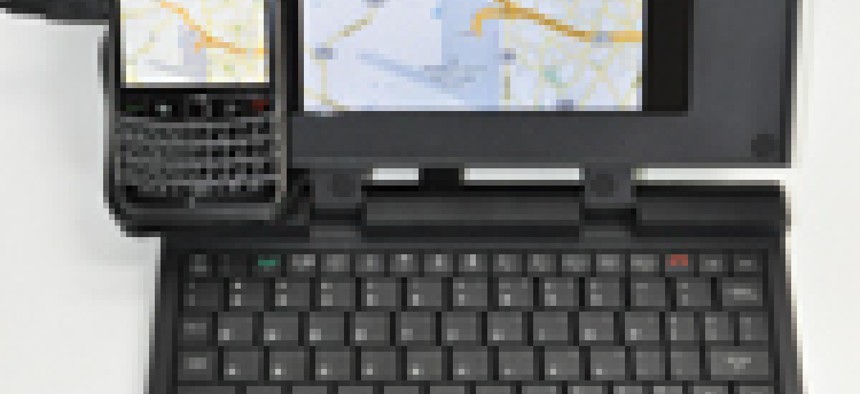Redfly swats tiny cell phone screens

The Redfly mobile Companion C7 can solve the problem of working with tiny cell phone screens.
With smart phones getting faster, sharper and more functional every month, it’s little wonder that more mobile workers are beginning to forgo their laptop PCs. But try to actually work on a smart phone, and it’s also easy to see why laptops aren’t going to disappear any time soon.
That’s why BlackBerry and Microsoft Mobile smart-phone users might find the Redfly Mobile Companion C7 from Celio a useful addition to their gadget collection. Redfly has created a device in a class of its own. It resembles a small netbook but does not have any memory or operating system, so no data can be stored on the device or stolen from it. Yet it gives smart-phone users the advantages of a keyboard they can type on and larger monitor to read. And it has the advantage of piggybacking on your phone’s existing data plan, so there are no additional wireless or tethering fees.
We tested the Redfly with a BlackBerry 9700 Bold smart phone. The device is easy and intuitive to use. Power it up, connect your phone to one of the device’s two USB 2.0 ports, download a 153K software file via your smart phone, and you’re in business.
Redfly Mobile Companion C7
The first advantage of the Redfly is the larger color monitor, which measures 7 inches diagonally. The image on the Redfly replicates what’s on the smart phone, which, in our test, resulted in an image measuring 4.75 inches wide by 3.5 inches high — more than four times the size of the BlackBerry 9700’s image. And it can be even larger for other selected BlackBerry and Windows Mobile smart phones. The device can also connect to a projector, monitor and other devices using Bluetooth 1.0 and 2.0.
E-mail messages, addresses and Web applications appear on the Redfly as they do on your smart phone, albeit slightly stretched. At 800 x 480 pixels, the resolution doesn’t quite match the clarity of the 9700, which boasts a 480 x 320 pixel screen. So a street name on a Google map that is cleanly rendered on the BlackBerry can look pixilated on the Redfly. But reading and typing e-mail messages won’t leave you feeling in need of a magnifying glass.
Navigating on the Redfly can sometimes feel like working on a PC via remote control. The touchpad on the Redfly is less granular in translating thumb swipes compared with the BlackBerry 9700's elegantly designed touchpad, making it easy to shoot past links or other locations on the Redfly screen. In some cases, it was easier driving the cursor on the Redfly screen from the BlackBerry to get where you wanted to go.
However, the real strength of the Redfly is its keyboard. Though the tight formation takes getting used to, the keys are big enough for touch typing. Even fast-thumbing BlackBerry pros will find they can type out e-mails at almost twice the speed on the Redfly.
And because the Redfly replicates what’s on your BlackBerry, the autofill, spell-check and shortcut functions operate in familiar ways, which makes learning the Redfly a breeze right out of the box. There are a few exceptions. For example, holding down a key to capitalize a letter on the BlackBerry results in merely a string of repeated letters on the Redfly.
At less than 1.75 pounds, the Redfly is solidly built yet light. And with an average of five hours of battery life, it will get most road warriors through the day. At a government price of $188, the price will quickly pay for itself in improved productivity. So if the only reason you’re taking a laptop on the road is to stay in touch with the office, the Redfly C7 will give you a reason to leave the laptop on the desk.
Celio, www.celiocorp.com





